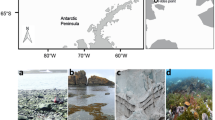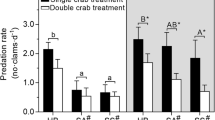Abstract
We evaluated the effects of potential predators from intertidal habitats on Strongylocentrotus purpuratus survival using laboratory experiments and assessed abundances of main predatory species along the Pacific coast of North America. The interactive effects of urchins’ and predators’ sizes in mediating predation were quantified. Habitat complexity (substrate pits, adult spine canopy) was manipulated to examine its effects on predation of most susceptible individuals (<14 mm). Pachygrapsus crassipes was identified as a major predator of urchins up to ≈30 mm. A positive effect of predator size on consumption of progressively larger urchins was detected, probably due to a mechanical limitation on crabs’ ability to consume large prey. Larger claws of males with respect to females of comparable sizes facilitated the handling of larger prey. Substrate refuges significantly reduced mortality on juvenile urchins. These results show that crab predation may be important in organizing intertidal communities, despite multiple ecological mechanisms promoting sea urchin survival.






Similar content being viewed by others
References
Anderson MJ (2001) Permutational tests for univariate or multivariate analysis of variance and regression. Can J Fish Aquat Sci 58:626–639
Andrew NL (1993) Spatial heterogeneity, sea urchin grazing, and habitat structure on reefs in temperate Australia. Ecology 74:292–302
Andrew NL, Choat JH (1982) The influence of predation and conspecific adults on the survivorship of juvenile Evechinus chloroticus (Echinoidea: Echinometridae). Oecologia 54:80–87
Bernstein BB, Williams BE, Mann KH (1981) The role of behavioural responses to predators in modifying urchins’ (Strongylocentrotus droebachiensis) destructive grazing and seasonal foraging patterns. Mar Biol 63:39–49
Breen PA, Carolsfeld W, Yamanaka KL (1985) Social behaviour of juvenile red sea urchins, Strongylocentrotus franciscanus (Agassiz). J Exp Mar Biol Ecol 92:45–61
Cameron RA, Schroeter SC (1980) Sea urchin recruitment: effect of substrate selection on juvenile distribution. Mar Ecol Prog Ser 2:243–247
Carpenter RC (1984) Predator and population density control of homing behavior in the Caribbean echinoid Diadema antillarum. Mar Biol 82:101–108
Cassone BJ, Boulding EG (2006) Genetic structure and phylogeography of the lined shore crab, Pachygrapsus crassipes, along the northeastern and western Pacific coasts. Mar Biol 149:213–226
Chapin D (1968) Some observations of predation of Acmaea species by the crab Pachygrapsus crassipes. Veliger 11:67–69
Clemente S, Hernández JC, Brito A (2009) Evidence of the top–down role of predators in structuring sublittoral rocky-reef communities in a Marine Protected Area and nearby areas of the Canary Islands. ICES J Mar Sci 66:64–71
Clemente S, Hernández JC, Rodríguez A, Brito A (2010) Identifying keystone predators and the importance of preserving functional diversity in sublittoral rocky bottoms. Mar Ecol Prog Ser 413:55–67
Connell JH (1975) Some mechanisms producing structure in natural communities: a model and evidence from field experiments. In: Cody ML, Diamond JM (eds) Ecology and evolution of communities. Harvard University Press, Cambridge, pp 460–490
Dayton PK, Rosenthal RJ, Mahen LC, Antezana T (1977) Population structure and foraging biology of predaceous Chilean asteroid Meyenaster gelatinosus and escape biology of its prey. Mar Biol 39:361–370
Duffy JE, Hay ME (2001) The ecology and evolution of marine Consumer-Prey interactions. In: Bertness MD, Gaines SD, Hay ME (eds) Marine community ecology. Sinauer, Sunderland, pp 131–157
Dumont CP, Himmelman JH, Russell MP (2006) Daily movement of the sea urchin Strongylocentrotus droebachiensis in different subtidal habitats in eastern Canada. Mar Ecol Prog Ser 317:87–99
Ebert TA (1983) Recruitment in echinoderms. In: Jangoux M, Lawrence JM (eds) Echinoderm studies, vol 1. Balkema, Rotterdam, pp 169–203
Ebert TA (2007) Sea urchins. In: Denny M, Gaines S (eds) Encyclopedia of tidepools and rocky shores. University of California Press, Berkely, pp 510–513
Ebert TA (2010) Demographic patterns of the purple sea urchin Strongylocentrotus purpuratus along a latitudinal gradient, 1985–1987. Mar Ecol Prog Ser 406:105–120
Elner RW, Hughes RN (1978) Energy maximization in the diet of the shore crab, Carcinus maenas. J Anim Ecol 47:103–116
Feder HM (1959) The food of the starfish, Pisaster ochraceus, along the California coast. Ecology 40:721–724
Garth JS, Abbott DP (1980) Brachyura: the true crabs. In: Morris RH, Abbott DP, Haderlie EC (eds) Intertidal invertebrates of California. Stanford University Press, Stanford, pp 594–630
Gaymer CF, Himmelman JH (2008) A keystone predatory sea star in the intertidal zone is controlled by a higher order predatory sea star in the subtidal zone. Mar Ecol Prog Ser 370:143–153
Grupe BM (2006) Purple sea urchins (Strongylocentrotus purpuratus) in and out of pits: the effects of microhabitat on population structure, morphology, growth, and mortality. MS thesis, University of Oregon
Guidetti P, Bussotti S, Boero F (2005) Evaluating the effects of protection on fish predators and sea urchins in shallow artificial rocky reefs habitats: a case study in the northern Adriatic Sea. Mar Environ Res 59:333–348
Hariston NG, Smith FE, Slobodkin LB (1960) Community structure population control and competition. Am Nat 94:421–425
Harrold C, Reed DC (1985) Food availability, sea urchin grazing, and kelp forest community structure. Ecology 66:1160–1169
Hereu B, Zabala M, Linares C, Sala E (2005) The effects of predator abundance and habitat structural complexity on survival of juvenile urchins. Mar Biol 146:293–299
Hernández JC, Russell MP (2010) Substratum cavities affect growth-plasticity, allometry, movement, and feeding rates in the sea urchin Strongylocentrotus purpuratus. J Exp Biol 213:520–525
Hernández JC, Clemente S, Girard D, Pérez-Ruzafa A, Brito A (2010) Effect of temperature on settlement and postsettlement survival in a barrens-forming sea urchin. Mar Ecol Prog Ser 413:69–80
Hiatt RW (1948) The biology of the lined shore crab, Pachygrapsus crassipes Randall. Pac Sci 2:135–213
Highsmith RC (1982) Induced settlement and metamorphosis of sand dollar (Dendraster excentricus) larvae in predator-free sites: adult sand dollar beds. Ecology 63:329–337
Himmelman JH (1986) Population biology of green sea urchins on rocky barrens. Mar Ecol Prog Ser 33:295–306
Hughes RN, Seed R (1981) Size selection of mussels by the blue crab Callinectes sapidus: energy maximizer or time minimizer? Mar Ecol Prog Ser 6:83–89
Hunt HL, Scheibling RE (1997) The role of early post-settlement mortality in recruitment of benthic marine invertebrates. Mar Ecol Prog Ser 155:269–301
Jennings LB, Hunt HL (2010) Settlement, recruitment and potential predators and competitors of juvenile echinoderms in the rocky subtidal zone. Mar Biol 157:307–316
Keats DW, South GR, Steele DH (1985) Ecology of juvenile green sea urchins (Strongylocentrotus droebachiensis) at an urchin dominated subtidal site in eastern Newfoundland. In: Keegan BF, O’Connor BDS (eds) Echinodermata. Balkema, Rotterdam, pp 295–302
Lessios HA (1988) Population dynamics of Diadema antillarum (Echinodermata: Echinoidea) following mass mortality in Panama. Mar Biol 95:515–526
Mann KH, Wright JLC, Welsford BE, Hatfield E (1984) Responses of the sea urchin Strongylocentrotus droebachiensis (O.F. Muller) to water-borne stimuli from potential predators and potential food algae. J Exp Mar Biol Ecol 79:233–244
Mauzey KP (1966) Feeding behavior and reproductive cycles in Pisaster ochraceus. Biol Bull 131:127–144
McClanahan TR (1998) Predation and the distribution and abundance of tropical sea urchin populations. J Exp Mar Biol Ecol 221:231–255
McClanahan TR, Kurtis JD (1991) Population regulation of the rock-boring sea urchin Echinometra mathaei (de Blainville). J Exp Mar Biol Ecol 147:121–146
McClanahan TR, Muthiga NA (1989) Patterns of predation on a sea urchin, Echinometra mathaei (de Blainville), on Kenyan coral reefs. J Exp Mar Biol Ecol 126:77–94
Menge BA, Sutherland JP (1976) Species diversity gradients: synthesis of the roles of predation, competition, and temporal heterogeneity. Am Nat 110:351–369
Menge BA, Sutherland JP (1987) Community regulation: variation in disturbance, competition, and predation in relation to environmental stress and recruitment. Am Nat 130:730–757
Nishizaki MT, Ackerman JD (2007) Juvenile-adult associations in sea urchins (Strongylocentrotus franciscanus and S. droebachiensis): protection from predation and hydrodynamics in S. franciscanus. Mar Biol 151:135–145
Ojeda FP, Dearborn JH (1991) Feeding ecology of benthic mobile predators: experimental analyses of their influence in rocky subtidal communities of the Gulf of Maine. J Exp Mar Biol Ecol 149:13–44
Paine RT (1980) Food webs linkage interaction strength and community infrastructure. J Anim Ecol 49:667–685
Pearse JS (2007) Ecological role of purple sea urchins. Science 314:940–941
Pearse JS, Hines AH (1987) Long-term population dynamics of sea urchins in a central California kelp forest: rare recruitment and rapid decline. Mar Ecol Prog Ser 39:275–283
Raymond BG, Scheibling RE (1987) Recruitment and growth of the sea urchin Strongylocentrotus droebachiensis (Müller) following mass mortalities off Nova Scotia, Canada. J Exp Mar Biol Ecol 108:31–54
Ricketts EF, Calvin J, Phillips DW, Hedgpeth JW (1985) Between pacific tides. Stanford University Press, Palo Alto
Roberts CM, Ormond RFG (1987) Habitat complexity and coral reef fishes diversity and abundance on Red Sea fringing reefs. Mar Ecol Prog Ser 41:1–8
Robles C, Sweetnam D, Eminike J (1990) Lobster predation on mussels: shore-level differences in prey vulnerability and predator preference. Ecology 71:l564–l1577
Rogers-Bennett L, Pearse JS (2002) Indirect benefits of marine protected areas for juvenile abalone. Conserv Biol 13:642–647
Rowley RJ (1990) Newly settled sea urchins in a kelp bed and urchin barren ground: a comparison of growth and mortality. Mar Ecol Prog Ser 62:229–240
Sagarin RD, Gaines SD (2002) Geographical abundance distributions of coastal invertebrates: using one-dimensional ranges to test biogeographic hypotheses. J Biogeogr 29:985–997
Sala E, Zabala M (1996) Fish predation and the structure of sea urchin Paracentrotus lividus populations in the NW Mediterranean. Mar Ecol Prog Ser 140:71–81
Sala E, Boudouresque CF, Harmelin-Vivien M (1998) Fishing, trophic cascades, and the structure of algal assemblages: evaluation of an old but untested paradigm. Oikos 82:425–439
Sanchez-Salalar ME, Griffiths CL, Seed R (1987) The effect of size and temperature on the predation of cockles Cerastoderma edule (L.) by the shore crab Carcinus maenas (L.). J Exp Mar Biol Ecol 111:181–193
Scheibling RE (1984) Echinoids, epizootics and ecological stability in the rocky subtidal off Nova Scotia, Canada. Helgoland Mar Res 37:233–242
Scheibling RE (1996) The role of predation in regulating sea urchin populations in eastern Canada. Oceanol Acta 19:421–430
Scheibling RE, Hamm J (1991) Interactions between sea urchins (Strongylocentrotus droebachiensis) and their predators in field and laboratory experiments. Mar Biol 110:105–116
Scheibling RE, Robinson MC (2008) Settlement behaviour and early post-settlement predation of the sea urchin Strongylocentrotus droebachiensis. J Exp Mar Biol Ecol 365:59–66
Sebens KP (1985) The ecology of the rocky subtidal zone. Am Sci 73:548–557
Shears NT, Babcock RC (2002) Marine reserves demonstrate top-down control of community structure on temperate reefs. Oecologia 132:131–142
Sousa WP (1993) Size-dependent predation on the salt-marsh snail Cerithideacalzjbrnica Haldeman. J Exp Mar Biol Ecol 166:19–37
Squires HJ (1990) Decapod Crustacea of the Atlantic coast of Canada. Can Bull Fish Aquat Sci 221:532
Tegner MJ, Dayton PK (1977) Sea urchin recruitment patterns and implications of commercial fishing. Science 196:324–326
Tegner MJ, Dayton PK (1981) Population structure, recruitment and mortality of two sea urchins (Strongylocentrotus franciscanus and S. purpuratus) in kelp forests. Mar Ecol Prog Ser 5:255–268
Tegner MJ, Levin LA (1983) Spiny lobsters and sea urchins: analysis of a predator-prey interaction. J Exp Mar Biol Ecol 73:125–150
Underwood AJ, Fairweather PG (1989) Supply-side Ecology and benthic marine assemblajes. Trends Ecol Evol 4:16–20
Urriago JD, Himmelman JH, Gaymer CF (2012) Sea urchin Tetrapygus niger distribution on elevated surfaces represents a strategy for avoiding predatory sea stars. Mar Ecol Prog Ser 444:85–95
Wicksten MK (2009) Decapod crustacea of the californian and oregonian zoogeographic provinces. Scripps Institution of Oceanography Library, Scripps Institution of Oceanography, UC San Diego
Witman JD (1985) Refuges, biological disturbance, and rocky subtidal community structure in New England. Ecol Monogr 55:421–445
Acknowledgments
We thank the staff from ‘Instituto de Investigaciones Oceanológicas’ (Universidad Autónoma de Baja California) for providing facilities and maintenance at the flowing seawater laboratory. S.C. benefited from postdoctoral fellowship from ‘Fundación Alfonso Martín Escudero’. The Ocean Science Division Biological Oceanography of the US National Science Foundation supported this study.
Author information
Authors and Affiliations
Corresponding author
Additional information
Communicated by S. Connell.
Electronic supplementary material
Below is the link to the electronic supplementary material.
Rights and permissions
About this article
Cite this article
Clemente, S., Hernández, J.C., Montaño-Moctezuma, G. et al. Predators of juvenile sea urchins and the effect of habitat refuges. Mar Biol 160, 579–590 (2013). https://doi.org/10.1007/s00227-012-2114-3
Received:
Accepted:
Published:
Issue Date:
DOI: https://doi.org/10.1007/s00227-012-2114-3




